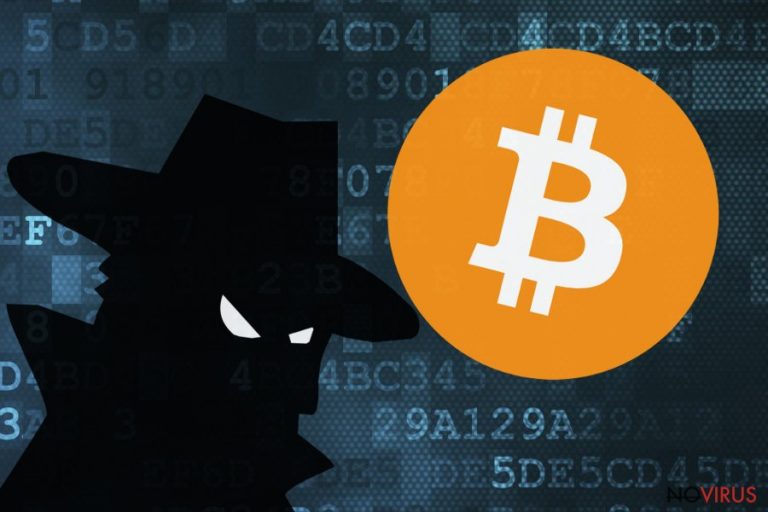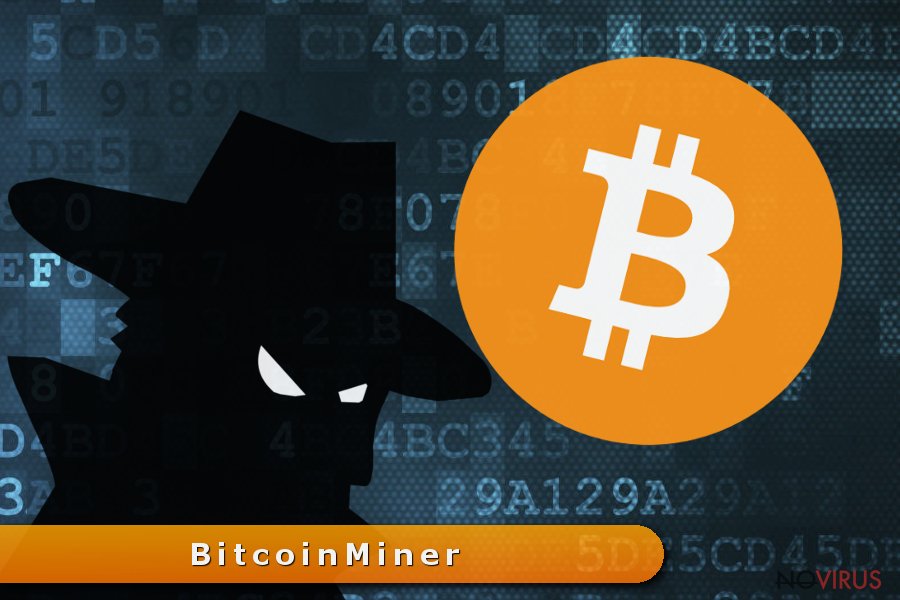Uninstall Bitcoin virus (Uninstall Instructions) - Aug 2017 updated
Bitcoin virus Removal Guide
Description of Bitcoin virus
Two versions of Bitcoin virus

As the name suggests, Bitcoin virus has something in common with virtual currency Bitcoins. Crooks developed and spread this computer infection to generate Bitcoins illegally. The affected computer becomes an actual money making tool. Even though malware has been created for generating Bitcoins, it can try to steal your money as well.
Bitcoin malware might try to steal your credit cards or banking information and with a couple of hours empty your bank account. This virus is also known as BitcoinMiner or Bitcoin Mining virus and has several versions that spread via different channels. However, the main way to distribute it is malicious Skype messages. Developers polished infiltration techniques so well that users rarely notice the signs of attack.
However, the main symptom of the infection is increased CPU. Therefore, you should not ignore this sign and scan computer with a reputable malware removal program such as FortectIntego.
However, there’s another version of the virus that can encrypt files on the affected computer. It’s Bitcoin ransomware. The first attack has been held in one medical centre in the United States. Unfortunately, it was not the only attempt to get Bitcoins from regular computer users.
When on the affected computer, ransomware looks for various file types and encrypts them using a sophisticated algorithm. When all necessary files are taken to the hostage, malware delivers a message informing about this unpleasant situation and demands paying 1.5 Bitcoin. However, paying the ransom is not an option to get back access to the lost files.
Crooks have created this virus to generate money illegally, so when they receive the payment, their goal is achieved. Unlocking your files depends on their mood or conscience. But you should not expect good intentions from cyber criminals, so the best decision is Bitcoin virus removal.
Unfortunately, virus elimination won’t recover corrupted files; however, you can try additional data recovery methods. Besides, if you have data backups stored in external devices, you don’t need to worry about data recovery or consider paying the ransom. Remove Bitcoin virus, plugin external device and copy your files!

How is it possible to get infected with this virus?
Bitcoin virus spreads as malicious spam message which reaches users via Skype and various social networks. The message includes a picture and has several text variants that encourage opening and downloading it to the computer. If users are tricked to do it, malware gets inside the system and starts its malicious activities. Therefore, if you want to avoid this infection, you should critically look to receive pictures or links.
Even though you know the person, but received file seems suspicious, you should ask him or her confirmation that it is safe to open. This malware distribution technique is also popular between other viruses creators, so you should be cautious and do not let curiosity rushing you into opening received file.
Bitcoin malware elimination guidelines
The only safe and reliable Bitcoin virus removal option is to employ a strong anti-malware program and run a full system scan. Manual removal usually ends up with huge failure, so we do not recommend trying to remove malware bare hands. Only experienced IT specialist can complete manual removal successfully.
Therefore, you should install and update reliable malware removal tool. FortectIntego, SpyHunter 5Combo Cleaner and Malwarebytes are perfect choices because all these programs are capable of detecting all virus-related components. If you have been infected with ransomware version, these programs will help you as well. However, sometimes malware blocks access to security tools or prevents from installing them. In this case, follow the instructions presented below. They will help to remove Bitcoin virus.
Getting rid of Bitcoin virus. Follow these steps
In-depth guide for the Bitcoin elimination
Important! →
The elimination guide can appear too difficult if you are not tech-savvy. It requires some knowledge of computer processes since it includes system changes that need to be performed correctly. You need to take steps carefully and follow the guide avoiding any issues created due to improper setting changes. Automatic methods might suit you better if you find the guide too difficult.
Step 1. Launch Safe Mode with Networking
Safe Mode environment offers better results of manual virus removal
Windows 7 / Vista / XP
- Go to Start.
- Choose Shutdown, then Restart, and OK.
- When your computer boots, start pressing the F8 button (if that does not work, try F2, F12, Del, etc. – it all depends on your motherboard model) a few times until you see the Advanced Boot Options window.
- Select Safe Mode with Networking from the list.

Windows 10 / Windows 8
- Right-click the Start button and choose Settings.

- Scroll down to find Update & Security.

- On the left, pick Recovery.
- Scroll to find Advanced Startup section.
- Click Restart now.

- Choose Troubleshoot.

- Go to Advanced options.

- Select Startup Settings.

- Press Restart.

- Choose 5) Enable Safe Mode with Networking.
Step 2. End questionable processes
You can rely on Windows Task Manager that finds all the random processes in the background. When the intruder is triggering any processes, you can shut them down:
- Press Ctrl + Shift + Esc keys to open Windows Task Manager.
- Click on More details.

- Scroll down to Background processes.
- Look for anything suspicious.
- Right-click and select Open file location.

- Go back to the Process tab, right-click and pick End Task.
- Delete the contents of the malicious folder.
Step 3. Check the program in Startup
- Press Ctrl + Shift + Esc on your keyboard again.
- Go to the Startup tab.
- Right-click on the suspicious app and pick Disable.

Step 4. Find and eliminate virus files
Data related to the infection can be hidden in various places. Follow the steps and you can find them:
- Type in Disk Cleanup in Windows search and press Enter.

- Select the drive (C: is your main drive by default and is likely to be the one that has malicious files in) you want to clean.
- Scroll through the Files to delete and select the following:
Temporary Internet Files
Downloads
Recycle Bin
Temporary files - Pick Clean up system files.

- You can also look for other malicious files hidden in the following folders (type these entries in Windows Search and press Enter):
%AppData%
%LocalAppData%
%ProgramData%
%WinDir%
After you are finished, reboot the PC in normal mode.
Eliminate Bitcoin using System Restore
-
Step 1: Restart your computer in Safe Mode with Command Prompt
Windows 7 / Vista / XP- Go to Start → Shutdown → Restart → OK.
- As soon as your computer starts, start pressing F8 key repeatedly before the Windows logo shows up.
-
Choose Command Prompt from the list

Windows 10 / Windows 8- Click on the Power button at the Windows login screen, and then press and hold Shift key on your keyboard. Then click Restart.
- Then select Troubleshoot → Advanced options → Startup Settings and click Restart.
-
Once your computer starts, select Enable Safe Mode with Command Prompt from the list of options in Startup Settings.

-
Step 2: Perform a system restore to recover files and settings
-
When the Command Prompt window appears, type in cd restore and press Enter.

-
Then type rstrui.exe and hit Enter..

-
In a new window that shows up, click the Next button and choose a restore point that was created before the infiltration of Bitcoin and then click on the Next button again.


-
To start system restore, click Yes.

-
When the Command Prompt window appears, type in cd restore and press Enter.
Bonus: Restore your files
Using the tutorial provided above you should be able to eliminate Bitcoin from the infected device. novirus.uk team has also prepared an in-depth data recovery guide which you will also find above.If your computer has been infected with Bitcoin ransomware virus, you should not transfer ransom to the cyber criminals. Instead of that remove malware from your PC and try additional data recovery methods.
There are a couple of methods you can apply to recover data encrypted by Bitcoin:
Try Data Recovery Pro
Data Recovery Pro is a professional tool created to help people restore their encrypted or accidentally deleted files. So, it may be helpful to restore at least some of the encrypted files.
- Download Data Recovery Pro;
- Install Data Recovery on your computer following the steps indicated in the software’s Setup;
- Run the program to scan your device for the data encrypted by Bitcoin ransomware;
- Recover the data.
Recocer individual files using Windows Previous Versions feature
This method can help you to decrypt individual files only if the System Restore function was enabled on your computer before ransomware attack. If it was, then try using this guide:
- Right-click on the encrypted document you want to recover;
- Click “Properties” and navigate to “Previous versions” tab;
- In the “Folder versions” section look for the available file copies. Choose the desired version and press “Restore”.
Retrieve your files with ShadowExplorer
If this ransomware did not remove Shadow Volume Copies of the target files, you can use ShadowExplorer to restore your encrypted data by following these steps:
- Download Shadow Explorer (http://shadowexplorer.com/);
- Install Shadow Explorer on your computer following the instructions in the software’s Setup Wizard;
- Run the program. Navigate to the menu on the top-left corner and select a disk containing your encrypted files. Look through the available folders;
- When you find the folder you want to recover, right-click it and select “Export”. Also, choose where the recovered data will be stored.
It is strongly recommended to take precautions and secure your computer from malware attacks. To protect your PC from Bitcoin and other dangerous viruses, you should install and keep a powerful malware removal tool, for instance, FortectIntego, SpyHunter 5Combo Cleaner or Malwarebytes.
How to prevent from getting trojans
Prevent the government from spying on you
As there is a growing debate in government about collecting users' data and spying on citizens, you should take a closer look at this issue and find out what shady ways of gathering information can be used to collect information about you. You need to browse anonymously if you want to avoid any government-initiated spying and tracking of information.
You can enjoy secure internet browsing and minimize the risk of intrusion into your system if you use Private Internet Access VPN program. This VPN application creates a virtual private network and provides access to the required data without any content restrictions.
Control government and other third party access to your data and ensure safe web browsing. Even if you do not engage in illegal activities and trust your ISP, we recommend being careful about your security. You should take extra precautions and start using a VPN program.
Reduce the threat of viruses by backing up your data
Due to their own careless behavior, computer users can suffer various losses caused by cyber infections. Viruses can affect the functionality of the software or directly corrupt data on your system by encrypting it. These problems can disrupt the system and cause you to lose personal data permanently. There is no such threat if you have the latest backups, as you can easily recover lost data and get back to work.
It is recommended to update the backups in parallel each time the system is modified. This way, you will be able to access the latest saved data after an unexpected virus attack or system failure. By having the latest copies of important documents and projects, you will avoid serious inconveniences. File backups are especially useful if malware attacks your system unexpectedly. We recommend using the Data Recovery Pro program to restore the system.







